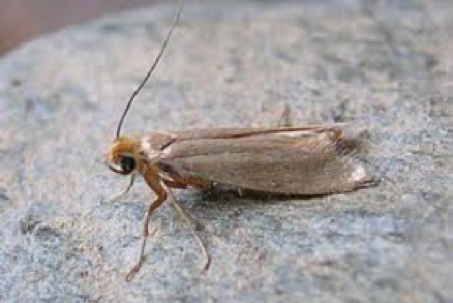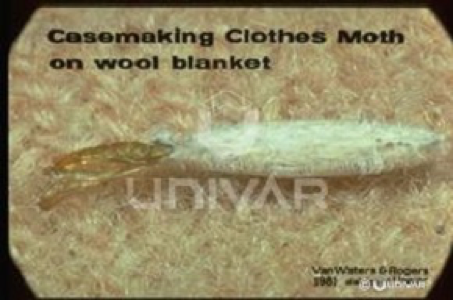Moths
Although Known for Eating Clothing, the Majority of Adult Moths Don’t Eat at All
 The Webbing Clothes Moth
The Webbing Clothes Moth
The adult has a body covered with shiny golden scales and the top of the head bears a fluffy pompadour of reddish golden hairs. The compound eyes are black and the antennae are darker than the rest of the body. The wings have no spots and fully expanded the adult moth is approximately ½ inch. When at rest the length of the body with wings is about ¼ inch. Only males and dwarf females will fly voluntarily but females will occasionally fly once they have laid their eggs.
This moth prefers to run and tends to stay in the darker areas of the house, sticking to the shadows. The female deposits her eggs among the threads of clothes and fabrics in closets and darker storage areas. They prefer cotton, silk, and wool but will also use other materials. The emerging larva will begin feeding immediately on fabric present. The larvae are the only ones that eat the clothing. They may spin a feeding tunnel of silk and may incorporate some of the fibers on which it is feeding as well as its fecal particles. The feeding tunnel is not portable and can be abandoned once the larva has decided to move elsewhere. Feeding tunnels are usually located under collars and cuffs in concealed areas. Moth activity is not confined to closets and is often found under and behind furniture. Under optimum conditions, the webbing clothes moth will have an average lifespan of 65 to 90 days. A female moth can lay eggs every month with the proper conditions and ability to mate. Only some larvae will make it to the adult moth stage.
 Casemaking Clothes Moth
Casemaking Clothes Moth
Is slightly smaller than the Webbing Clothes Moth and is only 3/8 in or so when fully expanded wingtip to wingtip. Both wings are long and narrow and the hind wings are fringed with long hairs. The body and wings are colored buff to golden with a brownish tinge except for three dark spots on each front wing, which may be indistinct or rubbed off with age.
The name “Casemaking” Clothes Moth is derived from the habit of the brown-headed larva spinning a silken case and interweaving into this some of the fibers on which it is feeding much like the Webbing Clothes Moth. Only these feeding tunnels are attached to the larva and are mobile. When the larva moves it thrusts its head and thoracic legs out of the case and drags it along with it. Unlike the Webbing Clothes Moth, the larva of the Casemaking Clothes Moth rarely spins the web on the material on which it is feeding. It rather crawls around and grazes here and there damaging the textile according to the time it takes feeding in one place. The life cycle is: egg hatching in 4-7 days. Larval stage lasting 68-87 days on average. This is the stage of damage to fabrics. 9-19 days as a pupa and finally 4-6 days as an adult looking to breed.
Have you spotted an unwanted critter in your home or business? If so, there's probably more where that came from! Contact Parish Termite & Pest Management today to schedule your free inspection and estimate.
